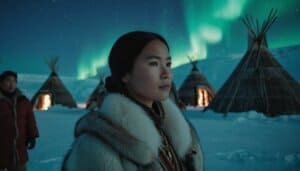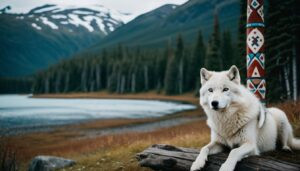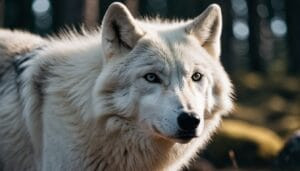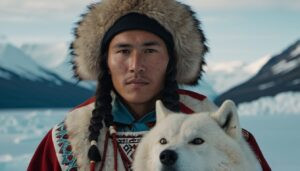Introduction
The Arctic wolf holds a special place in the cultural and spiritual life of Greenland’s indigenous communities
This article explores the traditional beliefs and cultural significance of Arctic wolves, delving into their role in Inuit mythology, depictions in folklore, and spiritual importance
Additionally, we will examine the cultural influence, symbolism, and impact of these majestic creatures on the natural and spiritual landscape of Greenland
Traditional Beliefs About Arctic Wolves In Greenland
Arctic wolves, also known as white wolves, are integral to the cultural and spiritual fabric of Greenland’s indigenous communities, particularly the Inuit
These magnificent creatures, adapted to the harsh conditions of the Arctic, have long been revered in Greenlandic traditions, where they are seen not just as animals but as spiritual beings that embody various aspects of nature and life
This section delves into the traditional beliefs surrounding Arctic wolves, exploring their role in Inuit mythology, their depictions in Greenlandic folklore, and their spiritual significance within indigenous cultures
Role of Arctic Wolves in Inuit Mythology
In Inuit mythology, Arctic wolves hold a significant place. They are often depicted as powerful and wise creatures, embodying traits that the Inuit admire and aspire to, such as strength, endurance, and the ability to survive in the most challenging environments
According to various Inuit legends, the Arctic wolf is a symbol of the natural world’s intelligence and cunning. One prevalent myth tells of a great white wolf who leads lost hunters back to their communities, guiding them through snowstorms and across treacherous ice
The Inuit believe that the Arctic wolf has a deep connection to the spirit world. It is often considered a messenger between humans and the spiritual realm. This belief is reflected in shamanistic practices, where shamans would invoke the spirit of the wolf to gain insights and guidance
The Arctic wolf’s howls were interpreted as communications from the spirits, conveying messages that needed to be deciphered and understood
Depictions in Greenlandic Folklore
Greenlandic folklore is rich with stories and tales that feature the Arctic wolf. These narratives often highlight the wolf’s role as a guardian and protector. For instance, there are numerous stories about wolves protecting villages from supernatural threats or helping humans in times of dire need
In one such tale, an Arctic wolf warns a village of an impending avalanche, allowing the villagers to seek safety in time
Folklore also portrays Arctic wolves as teachers and guides. Many stories describe how wolves impart knowledge about survival techniques, such as hunting and navigating the Arctic landscape. These tales emphasize the importance of living in harmony with nature and respecting the wisdom of all creatures
Additionally, the Arctic wolf is often depicted as a symbol of unity and family. Wolves are known for their strong pack dynamics, and this trait is reflected in folklore, where wolf packs are seen as models for human families and communities
The cooperative nature of wolves, their loyalty to their pack, and their ability to work together for the common good are traits that are highly valued in Greenlandic culture
Spiritual Significance in Indigenous Cultures
The spiritual significance of the Arctic wolf in Greenland extends beyond mythology and folklore
For many indigenous people, the wolf is a totem animal, embodying the qualities and virtues that individuals or clans strive to emulate. The Arctic wolf’s resilience, keen instincts, and ability to thrive in harsh conditions make it a powerful symbol of perseverance and strength
In traditional ceremonies, the Arctic wolf plays a pivotal role. Rituals and dances often feature wolf imagery and symbolism, celebrating the animal’s spiritual importance. For example, during certain rites of passage, participants might wear wolf masks or cloaks, invoking the wolf’s spirit to guide them through significant life transitions
Moreover, the Arctic wolf is seen as a spiritual guide and protector. People believe that the spirit of the wolf watches over them, providing protection and guidance. This belief is particularly strong among hunters and those who spend much of their lives in the wilderness
The presence of a wolf, whether physical or spiritual, is considered a good omen, signifying that the individual is being watched over and that they will be successful in their endeavors
Cultural Influence of Arctic Wolves in Greenland
The cultural influence of Arctic wolves in Greenland is profound, permeating various aspects of life, from stories and legends to traditional ceremonies and modern interpretations
These majestic animals are more than just part of the wildlife; they hold a significant place in the cultural heritage and collective consciousness of Greenlandic people
This section explores how Arctic wolves are woven into the cultural fabric of Greenland, highlighting their presence in stories and legends, their role in traditional ceremonies, and how their symbolism continues to evolve in modern times
Stories and Legends
Greenlandic culture is rich with stories and legends that feature Arctic wolves as central characters
These narratives often serve as moral tales, teaching lessons about bravery, community, and respect for nature. One popular legend tells of an Arctic wolf that saved a village from starvation by leading hunters to a hidden caribou herd during a particularly harsh winter. This story underscores the themes of cooperation and the interconnectedness of all life
Another well-known tale involves a lone Arctic wolf that befriends a young Inuit boy. The wolf teaches the boy the ways of the wild, helping him to become a skilled hunter and a respected leader in his community
This legend highlights the wolf’s role as a teacher and guide, emphasizing the importance of learning from nature and respecting its wisdom
These stories are passed down through generations, often told around campfires or during long winter nights. They are an integral part of the oral tradition, helping to preserve the cultural identity and values of Greenlandic communities
The Arctic wolf, through these tales, becomes a symbol of resilience, intelligence, and the enduring bond between humans and nature
Traditional Ceremonies
In Greenlandic traditional ceremonies, the Arctic wolf holds a place of honor. These ceremonies, which include rituals, dances, and celebrations, often feature wolf imagery and symbolism
For example, during the winter solstice, a festival that marks the return of the sun, participants might don wolf masks and perform dances that mimic the movements of wolves. This practice is believed to invoke the wolf’s spirit, bringing strength and protection to the community for the coming year
Another important ceremony is the initiation of young hunters. During this rite of passage, young men and women are often given tasks that emulate the challenges faced by wolves, such as enduring the cold or tracking prey
Successful completion of these tasks signifies that the individual has acquired the skills and qualities necessary to contribute to the community, much like the Arctic wolf does for its pack
Wolves are also prominent in shamanistic rituals. Shamans, or spiritual leaders, often invoke the spirit of the wolf to seek guidance or healing. They believe that the wolf’s spirit can provide insights into the natural world and help bridge the gap between the physical and spiritual realms
This connection is especially important in times of crisis, when the community looks to the shaman and the spirit of the wolf for support and direction
Modern Interpretations
In modern times, the cultural influence of Arctic wolves continues to evolve. While traditional beliefs and practices still hold significant sway, contemporary Greenlanders also find new ways to honor and integrate the symbolism of the wolf into their lives
Art, literature, and even popular media often feature Arctic wolves, reflecting their ongoing importance in Greenlandic culture
For instance, modern Greenlandic artists frequently depict Arctic wolves in their work, using a variety of mediums such as painting, sculpture, and digital art. These contemporary representations often blend traditional themes with modern aesthetics, creating a bridge between the past and the present
The Arctic wolf, in these works, symbolizes both a connection to ancestral heritage and a recognition of the natural world’s enduring influence
In literature, Arctic wolves appear in both traditional stories and new narratives. Authors and storytellers draw on the rich folklore of the past, reimagining old legends and creating new ones that resonate with today’s audiences
These stories often address contemporary issues such as environmental conservation, the importance of community, and the challenges of living in a changing world, using the Arctic wolf as a powerful symbol of resilience and adaptation
Additionally, the Arctic wolf is a prominent figure in environmental and conservation efforts. As climate change and habitat loss threaten the Arctic ecosystem, the wolf has become a symbol of the need to protect and preserve the natural world
Organizations and activists use the image of the Arctic wolf to raise awareness and rally support for conservation initiatives, highlighting the wolf’s role as an indicator species for the health of the Arctic environment
Symbolism and Impact of Arctic Wolves
The Arctic wolf holds deep symbolic meaning and has a significant impact on the cultural and natural landscape of Greenland. As an emblem of survival, adaptation, and the profound connection between humans and nature, the Arctic wolf’s presence resonates strongly in Greenlandic traditions and contemporary life
This section delves into the symbolism of Arctic wolves, exploring their representation as symbols of survival and adaptation, and their impact on both the natural and spiritual landscapes of Greenland
Natural and Spiritual Landscape
Arctic wolves are intrinsic to the natural ecosystem of Greenland. As apex predators, they play a crucial role in maintaining the balance of their environment
By regulating prey populations such as caribou and musk oxen, wolves ensure that these species do not overgraze the vegetation, thereby supporting the health of the entire ecosystem. This ecological role is deeply respected and mirrored in Greenlandic spiritual beliefs, where the wolf is seen as a guardian of nature’s balance
In the spiritual landscape, Arctic wolves are often viewed as guides and protectors. Their ability to navigate the harsh Arctic terrain symbolizes wisdom and the ability to find paths where none seem to exist
This trait is particularly significant in Inuit spiritual practices, where the Arctic wolf is believed to possess a heightened awareness and connection to the unseen world. Shamans, who act as mediators between the physical and spiritual realms, often call upon the spirit of the wolf to aid in their journeys and to seek guidance for their communities
The Arctic wolf’s howling, a sound that can travel great distances across the tundra, is also imbued with spiritual significance. It is often interpreted as a form of communication with the spirit world, carrying messages from ancestors or the spirits of the land
This belief underscores the deep spiritual connection that the Greenlandic people have with the Arctic wolf, viewing it as a bridge between the earthly and the divine
Symbol of Survival and Adaptation
The Arctic wolf’s ability to thrive in one of the planet’s most extreme environments makes it a powerful symbol of survival and adaptation. For the indigenous people of Greenland, who have also adapted to the harsh conditions of the Arctic, the wolf represents resilience and the ability to endure and prosper in adversity
This symbolism is reflected in many aspects of Greenlandic culture. In traditional clothing, for example, wolf fur is often used for its warmth and durability, symbolizing the protective qualities of the wolf
The use of wolf imagery in art and crafts, such as carvings and beadwork, also highlights the animal’s importance as a symbol of strength and survival
Furthermore, the Arctic wolf’s social structure, characterized by strong family bonds and cooperative hunting, is seen as a model for human communities. The wolf’s ability to work together in packs to achieve common goals mirrors the communal values of Greenlandic society
This parallel reinforces the idea that humans can learn valuable lessons from the natural world, particularly from creatures that exemplify resilience and teamwork
In contemporary Greenland, the Arctic wolf continues to be a symbol of cultural identity and pride
Environmental organizations often use the image of the wolf to promote conservation efforts, highlighting the need to protect the fragile Arctic ecosystem. The wolf, therefore, not only represents the strength and survival of the indigenous people but also the ongoing efforts to preserve their natural heritage
In literature and media, the Arctic wolf is frequently depicted as a hero or a guardian. These modern interpretations build on traditional beliefs, presenting the wolf as a timeless symbol of endurance and wisdom
Through these portrayals, the Arctic wolf continues to inspire and educate, reminding people of the importance of respecting and protecting the natural world
Conclusion
The Arctic wolf holds a profound and multifaceted place in Greenland’s cultural and natural landscape. Rooted deeply in Inuit mythology and Greenlandic folklore, Arctic wolves are revered as powerful spiritual beings, wise guides, and symbols of strength and survival
Through stories, legends, and traditional ceremonies, these majestic creatures embody the values and virtues admired by the Greenlandic people, such as endurance, resilience, and the ability to thrive in harsh conditions
Their influence extends beyond mythology and tradition, permeating modern interpretations and environmental conservation efforts. Arctic wolves continue to inspire contemporary art, literature, and activism, serving as a potent symbol of the need to protect and preserve the fragile Arctic ecosystem
By maintaining a balance in their natural habitat and providing spiritual guidance, Arctic wolves exemplify the deep connection between humans and nature, emphasizing the importance of living in harmony with the environment
Overall, the cultural and spiritual significance of Arctic wolves in Greenland highlights their enduring impact on the indigenous communities and the broader society. These creatures remain an integral part of Greenlandic heritage, symbolizing the unbreakable bond between people and the wild, and inspiring efforts to safeguard the natural world for future generations











